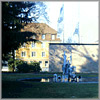 
|
Jean Tinguely
(Museum Tinguely) As a young man at the end of World War II, Tinguely was confronted with the horrible reality of the mass destruction of human life through both the Nazi killing machinery and the atom bomb. The MENGELE-Totentanz" (Death Dance) reflects the lingering effects of both this and the life-threatening personal experience of a major heart operation he had undergone shortly before. From childhood on, Tinguely was intimately familiar with the late-Middle Ages picture world of the Totentanz. This is represented in the Basel-art with the "Predigertotentanz" (Preacher Death Dance) and [Holbeins Imagines mortis] with famous examples of extremely high quality. For this reason, it was important for Tinguely to know that the MENGELE-Totentanz was kept in the good hands of the city of his childhood and youth. Here, he found the necessary support from art patrons to realize his plans to set up the entire Totentanz in a specially-created room. The completion of this project by the artist himself was not to be, however; he died in 1991. The task of bringing his vision to reality was the impetus for the founding of the Jean Tinguely Museum. Already in the second half of 1987, during his large retrospective in Venice's Palazzo Grassi, Tinguely had presented the group of sculptures in the small San Samuele church. In this setting, the distinct analogies to the models of the late Middle Ages are evident. In the period that followed, Tinguely was preoccupied with the idea of exhibiting the MENGELE-Totentanz in a specially-created, church-like room. The new presentation of the workgroup built upon the artist's ideas. It provides the opportunity to exhibit the anchoring of Tinguely's group in the centuries-old tradition of the Totentanz. The first room of the exhibit is dedicated to the artistic examination of the Totentanz since the late-Middle Ages. The exhibit does not strive for an encyclopedia-like overview, but instead allows the richness of the material to speak for itself. The vast number of presentations of the Totentanz, whose interpretation makes up an entire scientific branch, continuously covers the subject matter up to recent times. The exhibit is therefore largely limited to the Basel tradition, a fact that Tinguely evidently recognized with his remark, "I lived in Basel with the Totentanz." Read more at www.tinguely.ch |